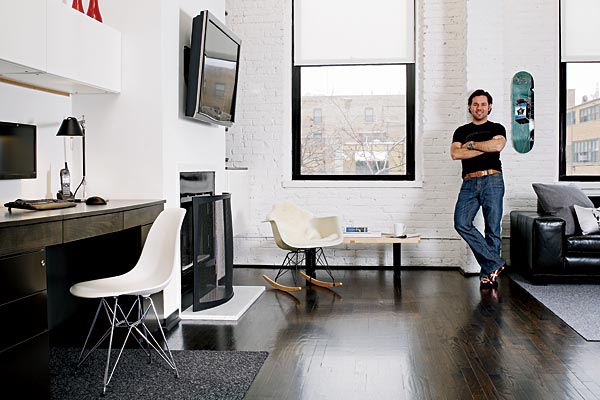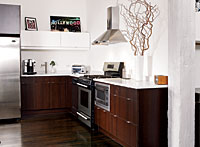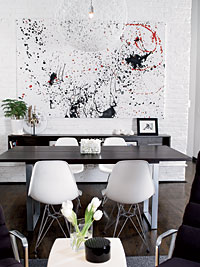
Arthur Mroczek’s love of functional design spans everything from the watch around his wrist to the urban loft he designed for himself. Photo Gallery »
When your job entails flying around the world to market the raucous live events of World Wrestling Entertainment—often traveling to 12 cities in as many days—your time off is precious. It’s important to be able to leave SmackDown! Live at the office, as it were, and come home to a clean, quiet, minimalist haven—which is exactly what Arthur Mroczek’s 1,000-square-foot West Town loft is.
Ironically, it is also his place of work. While based at WWE’s East Coast office four years ago, the Morton Grove native was asked to open a Chicago outpost and he generously offered to save the company rent money by setting up a workspace in what would be his future home. After months of trolling local real-estate ads online from New York, he bought a timber-and-exposed-brick loft sight unseen. It was well located and met his simple qualifications: “not a dump, but something basic—four walls and a ceiling—that I could completely redo the way I wanted it.”
A designphile who obsessively collects mechanical watches and snaps photos of toilets, fixtures, doors, and every other example of form meeting function that catches his eye during his world tours with WWE, Mroczek designed every detail of the space himself. He took advantage of his family’s extensive connections in the construction industry (“You see, I’m Polish,” he says with a laugh) to realize his vision: an urban loft as hip as a boutique hotel and as personal to him as Mom’s pierogi.
He reconfigured certain aspects of the original layout, eliminating a useless lofted “second bedroom” that had basically allowed room for a queen-sized bed, along with the staircase that led up to it. He also ran new electrical and plumbing through the space, which allowed him to move an oddly located washer and dryer to the entry closet and to strategically light areas of his choice. What was once a dark entryway now glows with track lighting; illumination from Bertjan Pot’s Random fiberglass orb (from Design Within Reach) defines the dining area.
One of the simplest updates was painting the entire space white, though it did take his painter seven days and 55 gallons of paint to achieve that. He also limited the loft’s color palette to white and dark brown, in the form of ebony stain on all the wood and one painted accent wall that extends from the kitchen into his bedroom.
To see the meticulous diagrams Mroczek created for his contractor, all while living in New York and visiting the space only monthly to take measurements (a tenant lived there until Mroczek’s company was ready to green-light his transfer), is to mistake him for a professional—though he does admit to some sloppy measuring. “I am so lucky those file cabinets fit under that desk,” he says, referring to the floating shelf that doubles as buffet and home office. The unit houses Mroczek’s laptop and has hidden storage compartments for his keyboard and office supplies, all of which can be stowed away when he has guests. It’s the kind of set-up most people would hire an interior architect to create. Mroczek seems to have been born with that gene, and now moonlights as a designer for friends and business associates.
“I had a solid year to sit around and think about how to maximize this space,” he says. And maximize he did. He gained a few feet in the living room by replacing a trapezoidal bank of walls around the fireplace with a rectangular enclosure that holds all the wires for his flat-screen TV, which hangs over the fireplace. On either side of this structure, he had a carpenter install built-in shelving and storage, including white Ikea cabinets.
Look closely and you’ll see a space-saving trick around every corner. In the entryway, behind the door, there’s stacked shelving for shoes made from maple recycled from a table that Mroczek no longer needed—he had it cut, sanded, stained in ebony, and hung on aluminum shelf-supports purchased at Home Depot. The kitchen has white cabinets from Ikea and custom ebony-stained cabinets from Cabinet World, including two narrow ones stacked alongside the refrigerator: bottom for a stepladder, top for cutting boards.
To conceal the closet in his bedroom, Mroczek opted for a massive curtain purchased at a canvas-supply store instead of traditional doors, saving him inches and gaining him “a nightlight—because the fixture in there shines from behind the curtain and creates a nice glow for the place.”
Photograph: Andreas Larsson
Related:

Within six weeks, Mroczek transformed a space that was utterly lacking in style into one that had his personal imprint. The change in the kitchen is perhaps the most dramatic. The goal was to create a functional place for cooking that connected smoothly with the rest of the living space. Similar pairings of white and dark brown appear throughout the loft. (For the "Before" picture, see the Photo Gallery)
When it came to budget, Mroczek was flexible—he splurged where he felt it was necessary. While he didn’t invest in a $4,000 stove, he did buy a top-of-the-line Franke sink and faucet and sprung for marble countertops in the kitchen. He also swears by his heated marble-clad floor in the bathroom. “It was the best $800 I’ve ever spent,” he says, adding, “I believe that small luxuries are always worth it in the end.”
Which is not to say he prefers to pay top dollar. His favorite furniture pieces, a pair of Eames Management chairs from the mid-1970s, were scored off of craig’slist.com. He bought them from a Philadelphia law office years ago and had them shipped to his parents’ home, as he has done with many other pieces in anticipation of eventually using them.
While much of the other furniture is from well-known modern sources such as Modernica and Design Within Reach, most of Mroczek’s accessories and artwork have personal stories, and it’s his very individual decorating style that makes this place tick. The walls hold an autographed photo of Ozzie Osbourne (a former client), a painting of Mozart by Andy Warhol’s understudy Steve Kaufman (“I’ve always loved Warhol, but could never afford him”), and a pop-arty Cat in the Hat painting with an Absolut vodka bottle in the foreground. (Mroczek designed and sold T-shirts to pay his way through John Carroll University: one said “Absolut Carroll” on it; one depicted the “Cat in the Hat smoking something at a Grateful Dead concert at Soldier Field, so this painting was a culmination of my early career in T-shirt sales,” he says.)

The loft’s revised floor plan (see Photo Gallery). Because large-scale art was not in Mroczek’s budget, he had to fend for himself when it came to the open wall behind his dining table. Undaunted, he splattered a huge canvas with paint and called it a day.
He even created his own Jackson Pollock–style splattered-paint canvas to cover a big space behind the dining table because, he says, he needed something “big and cheap.” The most touching work of art, though, is a photo of his grandfather’s hands, taken by Mroczek, that hangs in the entryway.
“My grandfather was a farmer and a butcher,” he says. “He moved here from Poland with my parents in 1972. His hands have a lot of character and I wanted to capture the life they have lived.” Mroczek did just that in a no-fuss way, with a digital snapshot, enlarged and framed—yet another example of form meeting function beautifully.
For resource information, see Buyer’s Guide.
Photography: Andreas Larsson
Related:



